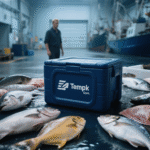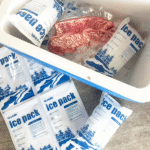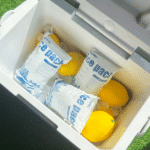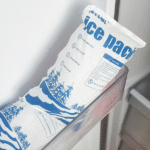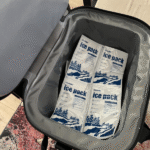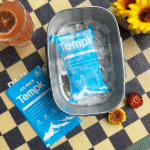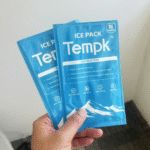Qual é a temperatura das bolsas de gelo seco em condições reais de envio? Na pressão padrão, gelo seco fica a -78,5 °C (−109,3 °F). Em um remetente, o ar interno normalmente se mantém entre cerca de -70 °C e -20 °C, dependendo do isolamento, ventilação, e colocação de pacotes. Você verá por que esse intervalo é importante, quanto gelo seco usar, e como permanecer em conformidade 2025.

-
Números exatos: que temperatura são as bolsas de gelo seco na superfície, na caixa de ar, e no núcleo do produto
-
Dimensionamento simplificado: matemática rápida para taxas de sublimação e um estimador de quantidade de gelo seco
-
Pacotes mais seguros: ventilação, rótulos (UN1845), e espaçamento para evitar danos por congelamento
-
Escolhas inteligentes: quando o gelo seco supera o gel/PCM – e quando isso não acontece
-
Tendências para 2025: membranas de ventilação, registradores com reconhecimento de borda, Recuperação de CO₂, e fluxos de trabalho digitais de GD
Qual é a temperatura das bolsas de gelo seco em condições reais de envio?
Resposta curta: O gelo seco está a -78,5 °C na fonte; o ar da caixa estabiliza mais quente (≈ −70 °C a −20 °C). O núcleo do produto fica atrás do ar e permanece abaixo de suas especificações se você dimensionar a massa e o isolamento corretamente. É por isso que temperatura são as bolsas de gelo seco é uma questão do sistema, não apenas um único número.
Por que isso importa: Se você precisar manter ≤−18/−20 °C (sorvete, sobremesas congeladas, alguns produtos biológicos), uma “bateria fria” de −78,5 °C oferece grande margem de segurança. Para 2–8 °C, gelo seco é muito frio—use gel ou PCM para evitar congelamento acidental.
Quanto gelo seco para começar?
Um estimador diário prático é:
Gelo seco (Libra) = (Horário de trânsito ÷ 24) × Taxa de sublimação (lb/24h)
Planeje com taxas típicas de acordo com a qualidade do remetente e adicione 10–30 % buffer para transferências e picos ambientais.
| Tipo de remetente | Qualidade de isolamento | Sublimação Típica (lb/24h) | O que isso significa para você |
|---|---|---|---|
| Espuma EPS (≈ 2″ parede) | Excelente | 4–6 | Ótimo para pistas de 48 a 72 horas |
| Plástico rígido + forro | Bom | 6–8 | Custo/manutenção equilibrado |
| Ondulado + forro | Moderado | 8–10 | Adicionar massa ou encurtar rota |
| Caixa de espuma para paletes | Prêmio | 10–20 / palete | Escala com aberturas e cubo |
Para a ponta: Muitas vezes é mais barato melhorar o isolamento do que continuar adicionando gelo seco. Paredes melhores reduzem perdas em todos os pontos de contato.
Padrões de posicionamento de pacotes que realmente funcionam
-
Somente carregamento superior: pias frias; observe o aquecimento inferior em pistas mais longas
-
Principal + fundo: gradientes mais planos para cargas de densidade mista
-
Cercar (lados + principal): perfil mais uniforme; precisa de mais massa inicial
-
Intersticial (entre camadas): pull-down rápido; adicione espaçadores para embalagens frágeis
Instantâneo do mundo real: Uma marca de sobremesas reduziu as variações de temperatura 38 % depois de mudar de blocos somente superiores para um padrão de pellet surround com a mesma massa.
Qual é a temperatura das bolsas de gelo seco vs.. pacotes de gel e PCM?
Resumindo: Use gelo seco para congelados (≤ −20 °C). Use gel/PCM para 2–8 °C ou CRT.
| Elemento de resfriamento | Ponto de ajuste / Comportamento | Melhor uso | Cuidados |
|---|---|---|---|
| Gelo seco (CO₂ ONU1845) | Sublime −78,5 °C | Pistas ultracongeladas | Ventilação necessária |
| Pacote de gel (0 °C) | 0 °C derrete | Comida gelada | Espera curta |
| PCM-21°C | Fase a −21 °C | Alimentos congelados | Condição prévia |
| PCM +5 °C | Fase ≈ +5 °C | Vacinas | Evite congelar |
| PCM +22 °C | Fase ≈ +22 °C | Pistas CRT | Precisa de isolamento |
Qual é a temperatura das bolsas de gelo seco na interface do produto – e é seguro?
Risco de contato: Uma superfície de -78,5 °C pode congelar itens sensíveis em contato. Adicione um espaçador (ondulado, bandeja de espuma) e distribuir pacotes uniformemente.
Lista de verificação de conformidade
-
Nome próprio “Dióxido de carbono, sólido (Gelo seco), Un1845 ”
-
Peso líquido de gelo seco na embalagem
-
Ventilado (nunca hermeticamente) recipiente
-
Aula 9 Etiqueta de perigo
-
Limpar remetente / informações do destinatário
| Tópico | Prática Essencial | O que evitar | Por que isso importa |
|---|---|---|---|
| Ventilação | Use aberturas de ventilação | Tampas herméticas | Evita o acúmulo de pressão |
| Rotulagem | UN1845 + peso + Aula 9 | Pesos ausentes | Aceitação mais rápida |
| Manuseio | Luvas isoladas | Contato com as mãos nuas | Evita lesões causadas pelo gelo |
Dicas práticas
-
Ciclos de porta: minimizar aberturas
-
Localização do registrador: perto do núcleo da carga útil
-
Projeto da pista: prefira curvas previsíveis, simetria não perfeita
Quanto gelo seco você precisa para pistas de 24 a 96 horas?
Exemplo: 48 h pista, Remetente EPS, ≈ 5 Libra / 24 h→
(48 / 24) × 5 = 10 Libra + 10–20 % buffer → 11–12 libras no total.
A validação supera a teoria – ajuste seu kit e pistas.
2025 tendências no controle de temperatura do gelo seco
Fresco em 2025: Membranas de ventilação mais inteligentes, registradores com reconhecimento de borda, Recaptura co₂, e fluxos de trabalho digitais de GD reduzem custos e emissões.
Destaques
-
Tampas de ventilação microporosas estabilizam o ar interno
-
Registradores com reconhecimento de borda detectam vazamentos de canto antecipadamente
-
Gelo seco com baixo teor de carbono proveniente da captura de CO₂
-
Declarações digitais reduzem erros
Insight de mercado: O crescimento congelado de DTC e produtos biológicos favorece os mais leves, pacotes surround com melhor isolamento para controle de custos.
Perguntas frequentes
Q1: Qual é a temperatura das bolsas de gelo seco no início de uma viagem?
Cerca de -78,5 °C na superfície/núcleo; o ar interno aquece de -70 °C a -20 °C dependendo do projeto.
Q2: Posso usar gelo seco para 2–8 °C?
Não. Está muito frio - use +5 °C PCM ou pacotes de gel.
Q3: Pelotas ou placas?
Os pellets são distribuídos uniformemente; lajes duram mais. Híbrido funciona melhor.
Q4: Quão próximo o gelo seco pode estar do meu produto?
Evite contato direto; use um espaçador e confie na temperatura do ar da caixa.
Q5: Quanto tempo dura o gelo seco?
Normalmente 18–96 horas dependendo do isolamento, massa, e ambiente.
Resumo & Recomendações
Pontos -chave: Qual é a temperatura das bolsas de gelo seco = fonte de −78,5 °C; aquecedor de ar de caixa.
Use gelo seco para pistas congeladas, PCM/gel para 2–8 °C. Sempre desabafe, rótulo, e registrar.
PRÓXIMOS PASSOS:
-
Defina a temperatura alvo & tempo de pista.
-
Escolha o refrigerante correto.
-
Estimar massa + 10–30 % buffer.
-
Use o layout Superior + Inferior ou Surround.
-
Validar com registradores.
CTA: Pronto para validar uma pista de −20 °C ou −70 °C? Reserve uma revisão de embalagem de 10 minutos com Tempk.
Sobre Tempk
Projetamos congelados validados, refrigerado, e pack-outs CRT com isolamento e acessórios comprovados que atingem perfis de −20 °C e −70 °C de forma confiável. Cada projeto é apoiado por dados piloto e POPs que as equipes podem seguir facilmente.

















